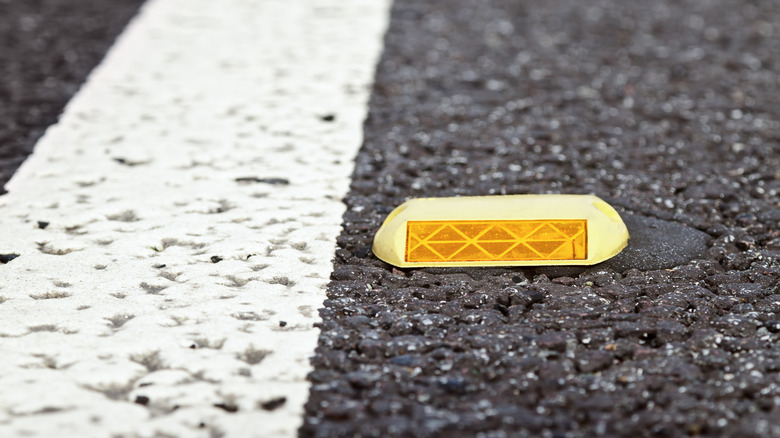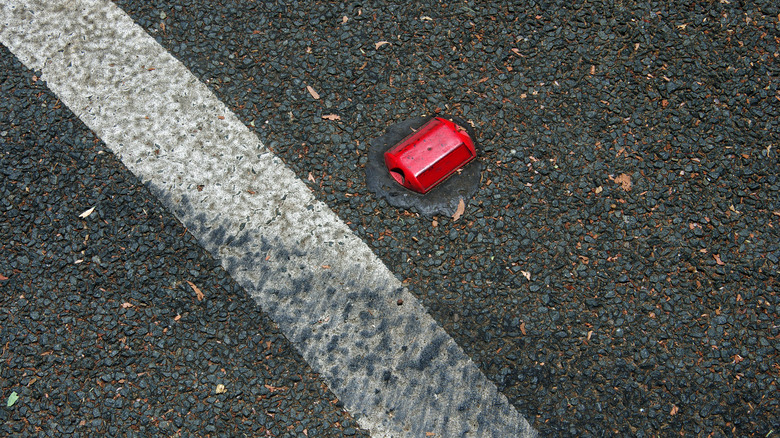What Do The Different Colors Of Road Reflectors (Cat's Eyes) Stand For?
If you're a driver (or even a passenger), you've seen them: small color-coded plastic markers in the center, or sometimes at the edge, of the road. They have various names; in the U.K., you'll hear them called "cat's eyes," while in the U.S., they're usually referred to as "road reflectors" or "raised pavement markers."
While apps like Waze can warn you about risks on the roads, road reflectors make sure you're aware of important road boundaries and hazards in real time. If you shine your headlights on them at night, they reflect the light back to guide you, helping you to stay in your lane and see where to go in the dark. Road reflectors perform similar functions during daylight hours, signaling things like the direction a road is headed and giving drivers audio and tactile feedback on the boundaries of the lane they're driving in.
You've probably noticed they come in various colors, including white, yellow, red, blue, and green. As you've probably guessed, each of these colors has a specific meaning designed to help drivers understand lane markings or identify hazards. They also help emergency responders and maintenance workers by marking the locations of fire hydrants, road exits, and access points for emergency vehicles, letting them find what they need quickly and efficiently.
The color of cat's eyes can change depending on where you are in the world, making it useful to know what local color codes stand for so you can avoid any surprises.
Common road reflector colors and their meanings
While there are differences between the colors and meanings of road reflectors from one region of the world to another, remember on your road trip that there's also some overlap.
In the U.S., white reflectors are used for lane markings or placed on the road's right edge. Similarly, in Europe and the U.K., white cat's eyes mark lanes or the center of the road, helping to guide drivers and separate lanes. If you see a yellow reflector in the U.S., it separates lanes of traffic moving in opposite directions or indicates the left edge on one-way roads. In Europe and the U.K., yellow also signals the edge of the central median.
But a red reflector in the U.S. says the road you're trying to get on isn't open to traffic or you're going the wrong way, while in Europe and the U.K., red cat's eyes are found on a highway's hard shoulders to reinforce the left-hand edge lines. And in Europe and the U.K., green is used to indicate junctions, road entrances, and exits, and less frequently to signal a frontage road. Green road reflectors in the U.S. are sometimes used to mark the access points for emergency vehicles to enter a gated community, letting emergency services know where they can enter without delay.
Special colors for emergency and utility markings
When there's an emergency, police and other first responders need to be able to locate equipment quickly, and raised pavement markers can help them do that. They work the same ways as cat's eyes and road reflectors designed to let drivers know where they get to go; the only difference is they alert emergency personnel to things like fire hydrants and access points, making it easier for them to respond quickly in emergency situations.
In the U.S. and Australia, a blue road reflector lets first responders know there's a fire hydrant nearby. These blue reflectors help firefighters and other personnel quickly identify water sources, especially in low-visibility conditions at night. In contrast, in Europe and the U.K., blue cat's eyes mark the emergency vehicle pull-offs and on-ramps or off-ramps, where police often stop to monitor traffic, making having an app on your phone to avoid speed traps a good idea in these areas.
Australia generally follows European conventions, with the exception of blue for fire hydrants.
Finally, you'll sometimes see a mix of colors on road reflectors in the U.S. For example, black and white is used to mark HOV lanes, and white, yellow or clear plus red lets drivers know they're going the wrong way or should not enter a certain area.


